
See how humans gave 'man's best friend' those puppy dog eyes
Can you tell what your pup is thinking just by taking a peek at its expression? You can thank 30,000 years of living with us for those expressive puppy dog eyes.
A recent study showed that our domesticated dog friends have an important difference from their wild wolf cousins, and it comes into play big time when your pooch gives you those beseeching looks.
Dr. Juliane Kaminski, a psychologist at the University of Portsmouth, has done numerous studies on how dogs and humans communicate, first looking at how canines decipher our directions, and now looking at how we interpret what they're trying to convey. Several years ago, this led her to try to find a common factor that made some shelter dogs get adopted before others. The common thread she found? A dog's ability to move its eyebrows upward and inward.
SEE ALSO: 'Punk' vest is actually protective for dogs
"It was a very surprising result," Kaminski told National Geographic. "We didn’t expect something as small as eyebrow movement to have a big effect."
In the study Kaminski and her team published this week, they looked at the structure of the facial muscles in several types of domesticated dogs and compared them to wild grey wolves. What they found raised eyebrows, literally.

Facial musculature in the wolf (C. lupus) (animal’s left) and dog (C. familiaris) (right) with differences in anatomy highlighted in red. Image courtesy of Tim D. Smith (Cambridge University Press, Cambridge, UK).
The levator anguli oculi medialis -- a prominent muscle that runs along the outer edge of the eye and exposes more white of the eye -- was present in all of the dog specimens, but nearly absent in the wolves. These muscles allow dogs to make their tell-tale 'big puppy dog eyes' expression.
"There’s no evidence that dogs move this [eyebrow] muscle intentionally, but it creates an exaggerated movement that for us means 'dog,'" Kaminski said, adding that eyebrows play a major role in human communication and body language. Specifically, the motion "resembles an expression that humans produce when sad," the team said.
Human influence on dog breeding is likely at the root of this change, according to the study's authors, as humans were preferentially drawn toward these 'sympathetic' pups. "In only 33,000 years, domestication transformed the facial muscle anatomy of dogs specifically for facial communication with humans," the team concludes.
Sources: PNAS | National Geographic |









